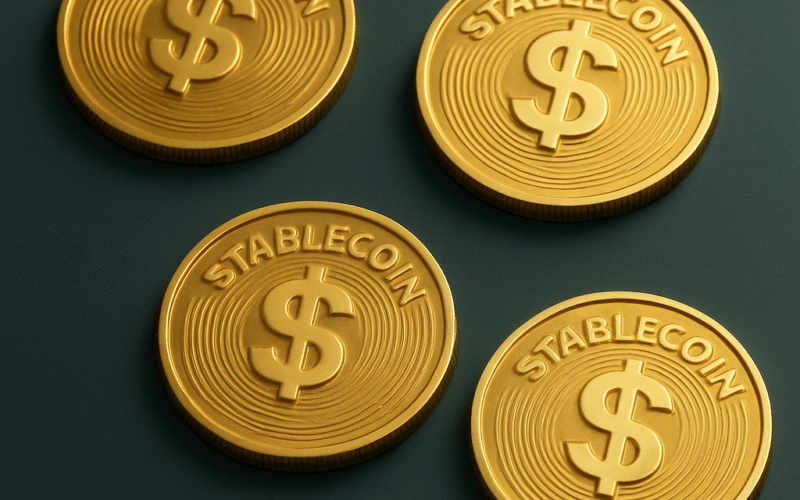Stablecoins have become one of the most practical uses of blockchain technology. Unlike volatile cryptocurrencies, they are designed to maintain a steady value, most commonly pegged to the US dollar or euro. For expats, businesses, and everyday users, they are increasingly a fast, low-cost way to move money worldwide. This Q&A breaks down what stablecoins are, how they work, and why new regulations in Europe and the US are changing the landscape.
Q: What is a stablecoin?
A: A stablecoin is a digital version of traditional money. Most are linked to the US dollar (USD), aiming to stay at $1 per coin. This is very different from cryptocurrencies like Bitcoin ou Ethereum, which can rise or fall by 10% or more in a single day. There are also Euro (EUR) stablecoins, though they are smaller in scale.
Q: How does it work?
A: You exchange your dollars or euros with the issuer, who provides you with the same number of tokens. These tokens can be transferred instantly, 24/7, anywhere in the world. When you want your money back, you return the tokens and redeem them at face value.
💡Think of it like PayPal money running on blockchain rails.
Q: Are they always safe? What went wrong with “algorithmic” stablecoins?
A: Stablecoins backed by real money and government bonds are generally safe. But in 2022, an “algorithmic” coin called TerraUSD (UST) collapsed. It wasn’t backed by reserves, but instead used a complex formula to stay at $1. When confidence broke, it failed, destroying billions of dollars. This event showed regulators the dangers and paved the way for strict new rules.
Q: What rules are now in place?
- Europe (including Malta): Le Règlement sur les marchés des crypto-actifs (MiCA) now requires stablecoins to be fully backed, audited, and issued by licensed entities. Importantly, issuers cannot pay interest (yield) to holders. That means you can use them as digital cash, but not as a savings product.
- United States: In 2025, the GENIUS Act introduced very similar rules: 100% safe reserves, public reporting, guaranteed redemption, and no interest to holders.
Together, these laws are moving stablecoins from the “Wild West” into mainstream finance.
Q: Why do businesses use them?
A: Stablecoins offer faster settlement, lower costs, and the ability to operate outside of traditional banking hours.
| Benefit | Explanation |
|---|---|
| Rapide | Payments settle in minutes, not days. |
| Cheap | Lower costs, especially across borders. |
| Always open | Works nights, weekends, and holidays. |
| Global reach | Pay suppliers or staff abroad without needing local bank accounts. |
| Mainstream adoption | Companies like Visa and Stripe now support stablecoin payments. |
Q: What do KYC and AML mean for users?
A: To use regulated stablecoin platforms, you must verify your identity through Know Your Customer (KYC) checks, much like opening a bank account. Transactions are also monitored under Lutte contre le blanchiment d'argent (AML) rules. For everyday users, this means a quick ID check at sign-up and stronger protection against fraud
Q: Where are stablecoins used now?
A: Stablecoins are no longer limited to crypto traders. Today, they are widely used in everyday finance and business operations:
| Use Case | Description |
|---|---|
| Paying freelancers and contractors | Fast international payments without relying on traditional banking delays. |
| Online shopping and marketplaces | Accepted on various platforms for quicker checkout and lower fees. |
| Sending remittances | A cheaper way to send money home across borders. |
| Managing company working capital | Provides liquidity and easier movement of funds for businesses. |
| Settling payments through Visa & Stripe | Supported by major payment providers, showing mainstream adoption. |
Q: How do they change finance?
A: Stablecoins make money move like email, instant, global, and low-cost. They also enable programmable payments, such as funds that only release once goods are delivered. This capability could transform payroll, trade, and logistics. Beyond speed, they reduce reliance on intermediaries like correspondent banks or escrow services, cutting down both time and fees. For businesses, this means smoother cash flow and fewer delays, while for individuals it creates a more direct and transparent way to send or receive money worldwide.
Q: What’s next for stablecoins?
A: In the future, stablecoins are expected to be used more widely in everyday business and personal finance. Companies may pay global teams directly in stablecoins, trade deals could settle automatically once goods are delivered, and loyalty points or gift cards may come in token form. Even machines and devices might start making tiny payments to each other, for example an electric car paying a charging station. As technology improves, these uses will likely become part of daily life.
Sidebar: Euro-stablecoins (EUR)
- Examples include EURC (Circle), EURS (Stasis)et EURe (Monerium).
- They remain much smaller than dollar coins because most global trade and crypto markets are dollar-based.
- Under MiCA, euro stablecoins fit naturally into the EU payment system, while non-euro stablecoins (like USD) may face caps on how widely they can be used for payments inside Europe.
- Some, like EUR, are issued by licensed European Electronic Money Institutions (EMIs) and come with full IBAN access — making them a natural bridge to the banking system.
Q: Should I use them?
A: For individuals, they can be a cheaper way to send money abroad. For businesses, they make cross-border payments faster and simpler. Just remember:
- they behave like digital cash, not savings accounts (no yield allowed),
- use regulated issuers,
- secure your wallet properly,
- and treat “extra-interest offers” with caution — they’re outside the law.
Bottom line
Stablecoins are digital dollars (and euros) designed for the internet age. With MiCA in Europe and the GENIUS Act in the US, they’re now tightly regulated. The collapse of TerraUSD showed what happens without real backing. Today, with companies like Visa and Stripe on board, stablecoins are moving from crypto niche to everyday finance.








